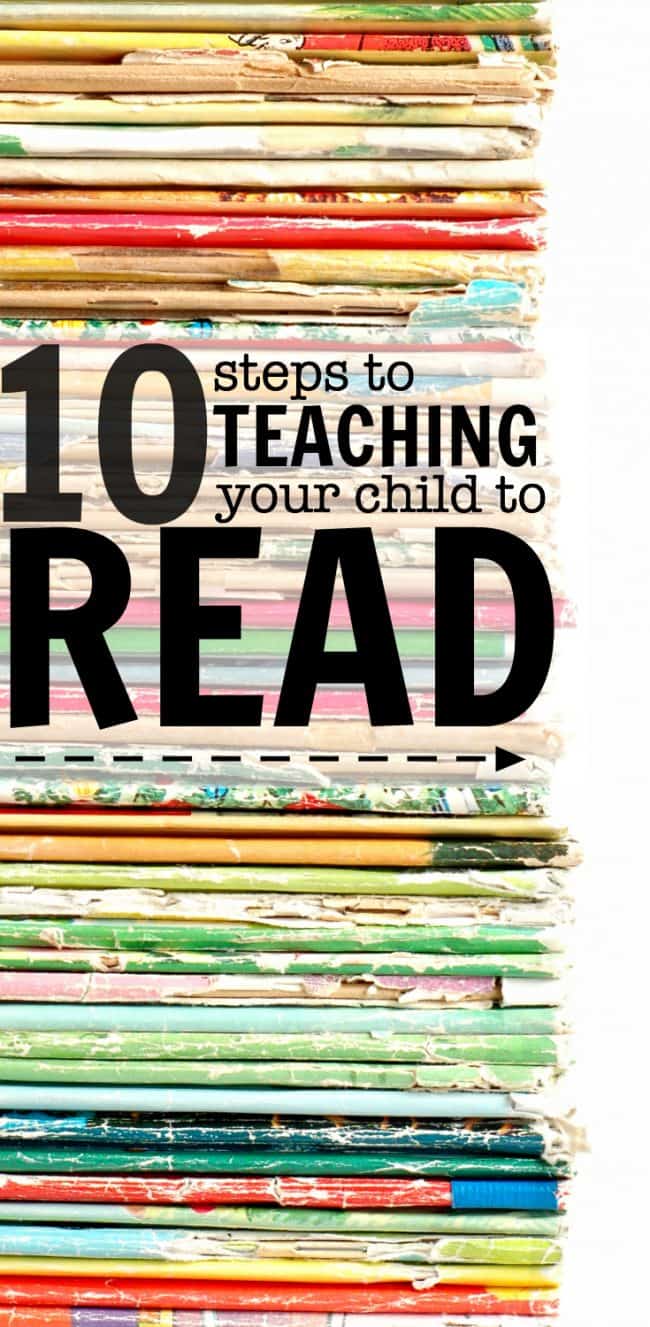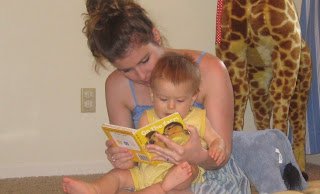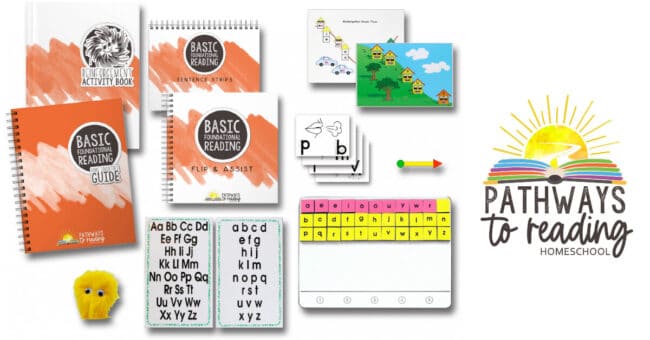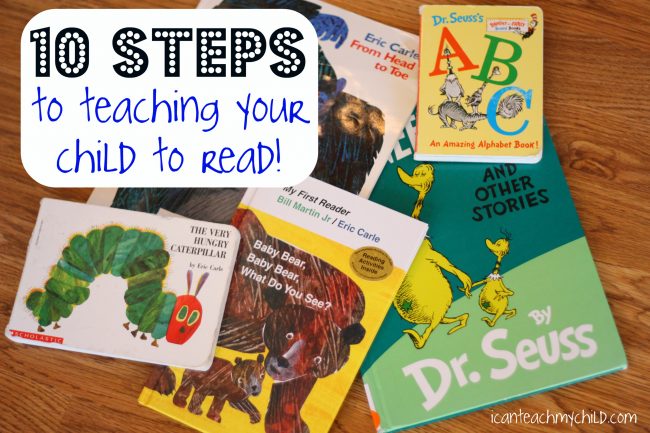How to Teach Kids to Read and Write
Educational activity your child to read can be one of the most rewarding experiences of your life! Hither we share 10 tips on how to teach a kid to read, from pre-readers all the way to school-age children!


When Do Kids Learn To Read?
Every bit a onetime commencement grade teacher, teaching children to read is one of my greatest passions! But considering most children don't start actually "reading" until around half dozen years erstwhile (which is upwards of the targeted historic period range for my blog), I didn't want parents to feel pressured that their 3-year old needs to kickoff reading (which, by the fashion, they don't!). Nonetheless, the information shared below is full general information that is beneficial for children of all ages, whether your kid is set to read or not. Don't implement all of these strategies at in one case, nor should yous look your child to exist able to do everything right away. Learning to read is a process and the information below is merely for y'all to implement when you feelyour child is gear up.
Once your child is set to begin reading, you volition need to detect a systematic and explicit program that teaches phonemic awareness and phonics. This is essential. Learning to read is like breaking a nada lawmaking (and opposite to what the title of this mail suggests, it is NOT piece of cake). Every child must acquire the lawmaking and information technology makes the most sense to teach this explicitly rather than depending on kids figuring it out on their own. Please also recognize that although the suggestions below are labeled as "steps", they are not necessarily in consecutive order, nor are they in guild of importance. The information y'all will find here is simply a guide to help you encounter how each of the components of reading fit together for your pre-reader. If your child is school-aged and you are looking for a curriculum on how to teach a child to read, I highly recommend Pathways to Reading Homeschool.
How To Teach a Child To Read
1. Read Aloudto your child
Teaching your child to read is truly a procedure that begins at infancy. No, I am most certainly Non advocating programs that claim to teach your baby to read using flashcards! What I AM encouraging you to do is to brainstorm reading with your newborn within days of welcoming her dwelling! Not only is ongoing reading time building a special bonding time for the two of y'all, information technology instills in her a beloved for books. Enjoyment while reading is 1 of the single greatest predictors of reading success in school-age children. If children don't learn from an early age to savour reading, information technology will near probable hinder their ability quondam downwardly the road.

How much you read to your child is completely upwardly to y'all and your family, but I suggest you aim to read at least iii-4 books a day, even while your child is very immature. As she gets a picayune older and can sit for longer stretches of fourth dimension, go far a family unit goal to read together for at least 20-minutes each day.
Hither are a few suggestions for the types of books to read to your child. Merely by all ways, read whatever your child responds to and enjoys!
- Birth-i Year: Lullabies, Board Books (with real pictures), Material Books (with various textures), Song Books
- 1 Year-3 Years: Rhyming Books, Song Books, Short-Story Board Books
- 3 Years-five Years: Alphabet Books, Vocal Books, Picture Books, Rhyming Books
2. Enquire questions
Asking questions while reading to your kid is not only groovy for encouraging your kid to interact with the book, just it is also extremely effective in developing his power to comprehend what he is reading. You see, if our main objective in "reading" is getting our child to "sound out" words, we have missed the boat entirely. Even children who can decode words and "read" with great fluency still might not be able to cover what they are reading. If a child can't comprehend what he is reading, there really is no betoken to reading at all!
While your child is a babe, enquire him questions such as, "Do you run across the cat?" while pointing at the picture of the cat. This will not only develop his vocabulary, it will besides encourage him to interact with the book that he is reading. As he gets older, ask him to signal to things in the book himself and brand the noises of the animals he sees.

One time your child is about 2 or 3-years of age, begin asking questions earlier, during, and after reading the volume. Evidence your kid the comprehend of the book and ask him what he thinks the story is going to exist about (predicting). While reading, ask him what he thinks is going to happen in the story or why he thinks a grapheme made a particular choice (inferring). If a character is depicting a potent emotion, identify that emotion and inquire your child if he has always felt that way (connecting). At the end of the book, enquire if his prediction(due south) came true. Later on, ask him to tell you what he remembered happening in the book (summarizing).
Modifying each of these techniques during read-alouds to meet the developmental stage of your child is a cracking way to promote and increment reading comprehension!
3. Be a good (reading) example
Even if your child is fascinated with books from an early on age, her fascination will quickly dwindle if she does not run across reading modeled in her home. If you are not an gorging reader yourself, brand a conscious effort to let your children meet you lot reading for at least a few minutes each day! Read a magazine, a cookbook, a novel, your Bible…it's up to y'all! But bear witness your child that reading is something that even adults need to practice. If you have a son, share this article with your husband. Sons demand to encounter their fathers read, especially since it is not something that young energetic boys are naturally prone to doing.

As parents, we can sometimes become wrapped upwardly with what exactly our children should be doing to be successful. But we ofttimes forget that children often learn by example. Grab a book and take a load off…for your kid's sake, of course!
4. Identify letters in natural settings
Before our boys were born, we painted and hung big wooden letters spelling their name to a higher place the cribs as a decorative accent in their rooms. I would have never guessed that those wooden messages would have such a learning incentive for Big Brother! Effectually age 2.v, he began asking what letters were above his name. That's honestly how he learned to spell his proper name…and he can spell his brother's name too because he has taken an interest in his letters also. In technical terms, this is called "ecology print" and includes all of the print we are surrounded past–fast food signs, labels, traffic signs, clothing, magazines, etc.

Often times, nosotros want to force our children to learn letter names past a certain age. We buy flashcards or DVDs claiming to teach our children their letters. We drill our ii-twelvemonth sometime over and over for minutes on end. Don't buy into this…allow your kid to be a child and take advantage of the "teachable moments" equally they come along! Children's minds are similar sponges and are certainly capable of memorizing the alphabet from drilling, but that'southward not the nigh constructive method that will produce the best long-term results. Your kid will be curious about the print he sees around him and will ask questions. That's your chance to leap in with a practical application that really has existent significant and significance to your child.
Don't misunderstand me and call up that I don't call up learning the alphabet is of import. It is certainly of import…simply the method in which we teach them is even more important! Always keep in heed that our ultimate goal is to foster a lifelong learner who loves to read, non a child who has simply memorized without any significance.
v. Comprise multiple domains of development
Children learn best when multiple senses or areas of development are included. That'due south why hands-on learning produces longer retention and more than meaningful application. One time your child has shown an interest in letters and you accept already begun to use natural settings for identifying those letters, begin implementing activities that incorporate every bit many senses as possible. Meep in mind that learning letter names isn't nearly as important every bit learning their sounds!
At that place are a plethora of ways to incorporate multiple domains of evolution in regards to letter of the alphabet recognition and early-reading skills. Alphabet crafts let your kid to learn the shape of a letter along with an association of the sound it makes all the while utilizing fine motor skills in the process of cutting, gluing, and creating! Playing games that involve gross motor skills (like tossing beanbags on the appropriate letter) are also wonderful ways to include motility. Of course, every kid loves songs and rhymes! Take an inventory of your kid's strengths and areas of interest and target activities to fit them!

6. Classify the Genre
Once your child is around five and can recognize the deviation betwixt real and make-believe, I would propose starting to assist your kid understand various genres of books during your reading fourth dimension together. This might seem complicated, merely it's actually not. In that location are around v unlike genres of children's books that I would encourage you to point out to your niggling one. Of class you can use the term "blazon" rather than "genre" if that is easier to remember.
- Nonfiction (real stories or facts about animals, places, people, etc)
- Fantasy (make-believe, tin can't happen in real life because of magic, talking animals, etc)
- Realistic Fiction (a fabricated-up story, just information technology could technically happen in real life because the characters and situations arebelievable)
- Alphabet Books
- Vocal Books

When children classify a volume into a sure genre, they accept to first summarize the book in their caput and retrieve details. And so they have to utilize that information to decide which type of genre that item books fits into. Finally, your child will be recalling details from other books in the same genre, making connections between the two. This unproblematic activity that might take 5-10 seconds of your fourth dimension subsequently reading a book only it certainly packs a dial of idea and processing in that young brain!
Also, it's important to note that not all books will fit into one of these genres, especially books that are considered "phonics readers." I would advise that you exercise this exercise only with high-quality children'southward literature, not with books that are attempting to get your child to "sound-out" on their own. Most picture books found in children's libraries volition fit into i of these genres.
Remember, our goal is for our children to learn to comprehend what they're reading…otherwise reading will honestly do them petty good. When we encourage our children to think about and process the book we've merely read together, we are inadvertently modeling what we hope they'll 1 solar day do independently!
7. Focus on Phonemic Sensation and Phonics
"Phonemes" are the smallest sounds in the English language (get hither for a complete listing of phonemes). These sounds are made upwardly of consonants, short vowels, long vowels, and digraphs. "Phonemic Sensation" consists of learning those sounds and how to manipulate them within a word. Digraphs are unique sounds comprised of private letters like /th/, /sh/, /ch/, etc.
"Phonics" includes learning how to spell those sounds and the diverse rules that the English language linguistic communication follows. Learning the rules of phonics is an essential tool that helps a child learn to decode and spell. I used the Pathways To Reading programme in the classroom as my phonemic awareness and phonics program and loved information technology! It fabricated learning all of the catchy spellings so much fun! Pathways now has a homeschool version, which is amazing!
9. Decoding
Decoding is often referred to as "sounding it out." Once your child knows the sounds each letter makes (which is taught in real, meaningful situations), she is ready to brainstorm putting words together. Decoding is a procedure that requires potent phonemic sensation skills and gives way to orthographic mapping, the process by which words are stored equally "sight words" in long-term retentiveness.
Equally children decode words with more than frequency, they will become more than proficient at automatically identifying that give-and-take. Researchers say information technology tin take between i-4 exposures of decoding before a word is transferred to long-term memory for automatic retrieval. Sometimes this task is tiresome, and tin can't be brusque-changed, and then it'due south important to find artistic means to make it fun. When I taught start grade, I used to buy little finger puppets that my students could utilise to bespeak to the messages as they were decoding. This was a huge hitting and fabricated this procedure so much fun!
10. Use a reading program with explicit, systematic instruction once he/she is in kindergarten and across
Most of the skills upwards to this point are what I would consider "pre-reader" skills that we, equally parents, can work on during our child's earliest years to make the process of learning to read much easier for our children. One time your child reaches school-historic period, exist certain that you are using a program rooted in the science of reading, with explicit and systematic instruction in both phonemic awareness and phonics. If your child is headed to school, enquire to look over the curriculum to ensure it is stiff in these areas specifically. Some children will naturally learn the phonetic code more easily than others, equally Nancy Immature'southward Reading Ladder suggests, but ALL children benefit from early code-based instruction.
In that location is no meliorate foundational reading program, in my opinion, than Pathways to Reading. The original curriculum has been used in classrooms and clinical settings for the terminal 20 years. The program has been involved in numerous enquiry studies, showing statistically significant results. Pathways to Reading Homeschool now offers their groundbreaking curriculum for home educators, starting with Bones Foundational Reading (which is the equivalent of kindergarten-historic period education). All 5 areas of reading educational activity, as identified by the National Reading Console, are incorporated: Phonemic Awareness, Phonics, Vocabulary, Fluency, and Reading Comprehension. This is such an incredible resource for families and I tin't recommend it highly enough!

Learning To Read is a Journeying
In summary, here are some practical suggestions y'all can implement every twenty-four hour period based on the learning to read strategies shared with you in this post. Evidently, you can't implement all of these suggestions with children of all ages, so use your sentence about what is the best fashion to teach a child to read.
- Read to your child every day!
- Inquire your kid questions earlier, during, and after reading.
- Allow your child run across you reading.
- Expect for letters while out and well-nigh and in the environs around you.
- When teaching letters and letter sounds, comprise equally many senses equally possible.
- Read a variety of books and make a game out of guessing the genre.
- Have fun rhyming
- Play these oral phonemic awareness games together (no materials required)
- Encourage your child to sound out short words (consonant, vowel, consonant).
- Most of all, have fun together!
This post was first published Feb 2012. Updated 2018.

Source: https://www.icanteachmychild.com/10-steps-to-teaching-your-child-to-read/
0 Response to "How to Teach Kids to Read and Write"
Post a Comment